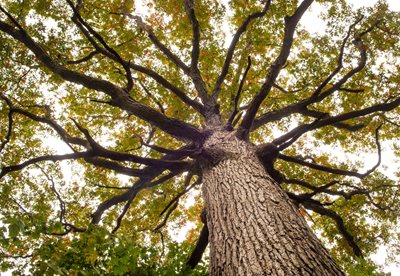Cleveland Metroparks manages ~18,000 acres of forest distributed throughout the park system. Forests provide a wide range of ecosystems services to northeast Ohio and its residents by creating wildlife habitat, mitigating climate impacts, filtering stormwater, and reducing air pollution. Maintaining healthy forests is essential to ensuring the continued provisioning of these services into the future. Biotic and abiotic stressors such as invasive plants, forest pests and pathogens, and climate change work individually and in conjunction to decrease forest health and resilience. To manage against these stressors, Cleveland Metroparks employes targeted early detection surveys for potential threats and follow-up monitoring to assess the effectiveness of management efforts. The data collected is essential for Cleveland Metroparks to respond to new forest health threats and adjust management strategies as needed.
-
First detected in the United States in Lake Country, OH in 2012, BLD was found in Cleveland Metroparks’ North Chagrin Reservation in 2014. Caused by the invasive nematode Litylenchus crenatae, BLD is characterized by leaf banding, thickening, and curling of leaf tissue; branch dieback; and an overall loss of canopy cover in American beech trees. Saplings are particularly susceptible and frequently die within 5 years of infestation while larger trees persist for longer. Large beech tree mortality has been documented throughout the park district; however it is currently unknown if mortality is inevitable. Ongoing research by Cleveland Metroparks and collaborators with Holden Forests and Gardens and the UADA Forest Service seek to find potentially resistant beech trees.
Picture on the left shows beech branch with leaves of 3 conditions: no symptoms; mild BLD leaf symptoms (intervein banding) and heavy BLD symptoms (dark green, shrunken and shriveled). Picture on the right shows a large dying beech tree with significant canopy loss)
Beech are an important component of the beech/sugar maple-mixed hardwood forest which together comprise >40% of Cleveland Metroparks forestlands. Living up to 400 years, they are one of the longest-lived tree species in the region and are an important componenet of many mature and old growth forest stands such as North Chagrin’s A.B. Williams Memorial Woods. Their loss would dramatically alter the region’s forests.

Since the initial discovery, BLD has spread to 15 states and Canada. Situated at the epicenter of the pathogen’s emergence, Cleveland Metroparks has been active in early research to better understand this novel disease. Working with federal and state agencies, industry and non-profit institutions, academic laboratories, local park districts, conservation organizations, and citizen scientists, projects have included developing a long-term monitoring protocol to enable the study symptom development over multiple growing seasons, monitoring BLD distribution and severity, experimenting with chemical treatments, and identifying potentially resistant trees.
One such collaboration began in 2016 with the Davey Tree Expert Company has yielded promising early result on the effectiveness of the common turf fertilizer polyphosphate 30 in suppressing symptoms and improving survival. CMP has begun translating this research into management by treating high priority trees.
Research Publications (names in bold are current or past Cleveland Metroparks staff):
- Martin, D., Hausman, C., Volk, D., Reed, S., Macy, T., Pogacnik, J., & McIntire, C. (2024). BLD long-term monitoring plot protocol. Zenodo. https://doi.org/10.5281/zenodo.10926805
- Loyd, A.L., Cowles, R.S., Borden, M.A., LaMondia, J.A., Mitkowski, N., Faubert,H., Burke, D., Hausman, C., Volk, D., Littlejohn, C., Stiller, A., Rigsby, C.M., Brantley, B. and Fite, K. (2024) Exploring Novel Management Methods for Beech Leaf Disease, an Emerging Threat to Forests and Landscapes. Journal of Environmental Horticulture. 42 (1)1-13. https://doi.org/10.24266/0738-2898-42.1.1
- Hausman, C., & Volk, D. (2023). Range extent, symptom progression, and identification of the causal agent of undiagnosed beech leaf disease-final report. Zenodo. https://doi.org/10.5281/zenodo.15042112
- Fearer, C. J., Volk, D., Hausman, C. E., & Bonello, P. (2022). Monitoring foliar symptom expression in beech leaf disease through time. Forest Pathology, 52(1), e12725. https://onlinelibrary.wiley.com/doi/abs/10.1111/efp.12725
- Reed, S. E., Volk, D., Martin, D. K., Hausman, C. E., Macy, T., Tomon, T., & Cousins, S. (2022). The distribution of beech leaf disease and the causal agents of beech bark disease (Cryptoccocus fagisuga, Neonectria faginata, N. ditissima) in forests surrounding Lake Erie and future implications. Forest Ecology and Management, 503, 119753. Sciencedirect.com/science/article/pii/S0378112721008446?via%3Dihub
- Ewing, C.J., Hausman, C.E., Pogacnik, J., Slot, J., Bonello, P. (2018). Beech leaf disease: an emerging forest epidemic. For. Pathol., 49 (2019), p. e12488, 10.1111/efp.12488 https://onlinelibrary.wiley.com/doi/10.1111/efp.12488
-

In 2021, Cleveland Metroparks and The Lubrizol Foundation partnered to make the Park District’s forests more resilient to the impacts of climate change. With funding from The Lubrizol Foundation, Cleveland Metroparks Natural Resources team is calculating the amount of CO2 captured by its trees, and studying carbon storage and sequestration across the forested areas of the Park District.
Cleveland Metroparks spans more than 25,000 acres, including approximately 18,000 acres of forests. According to a study by the U.S. Forest Service Landscape Change Research Group, more than a third of tree species across Northeast Ohio will be less able to survive by the end of the century due to the impacts of climate change. As trees are one of the most powerful tools to combat climate change by capturing and storing harmful CO2 from the air, their protection is essential to the health of the region. Visit our new Tree Selector Tool for help choosing the right trees for your yard or landscape.
Using the research and information generated by this three-year partnership, Cleveland Metroparks is developing guidelines and information about best forestry and conservation techniques to use to preserve and continue the important work of trees in this area to counter the effects of climate change.
Funding for this work was made possible through support from the Charles L. Pack Trust and The Lubrizol Coorporation

Research Publications (names in bold are current or past Cleveland Metroparks staff):
